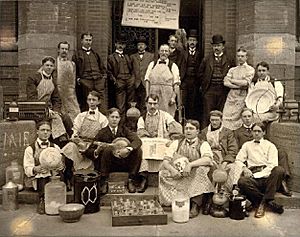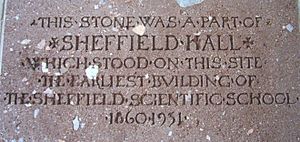Sheffield Scientific School facts for kids

Chemistry Class in 1898
|
|
| Type | Private |
|---|---|
| Active | 1847–1956 |
| Affiliation | Yale University |
| Location |
,
,
United States
|
The Sheffield Scientific School was a special part of Yale University in New Haven, Connecticut. It started in 1847 to teach students about science and engineering. At first, it was called the Yale Scientific School. In 1861, it was renamed to honor Joseph E. Sheffield, who was a successful railroad businessman.
This school helped create a new way of learning in American universities. It combined science and engineering with subjects like history and literature. After World War I, the school's classes slowly became part of Yale College. The "Sheff", as it was often called, stopped being a separate school in 1956.
Contents
History of the Sheffield Scientific School
After new inventions like the electric telegraph in the early 1800s, people became very interested in teaching practical science at universities. Other schools like Harvard and Dartmouth also started science schools around this time.
How the School Started
At Yale, things began to change in 1846. Two professors, John Pitkin Norton and Benjamin Silliman Jr., started teaching "agricultural chemistry" and "practical chemistry." In 1847, their classes became part of a new "Department of Philosophy and the Arts." This department later became the Yale Graduate School. The first classes and labs were held in the Second President's House on Yale's Old Campus.
When Professor Norton passed away in 1852, John Addison Porter took over. In 1852, a new professor, William Augustus Norton, began teaching "civil engineering." These new programs formed the Yale Scientific School.
Sheffield's Generous Gift
In 1853 and 1854, the Yale Scientific School's courses were listed in the main Yale College catalog. Professor Porter asked his father-in-law, Joseph Earl Sheffield, for help. In 1858, Sheffield gave over $100,000 to buy and fix up the old Medical Department building for the science school. This gift included two newly updated parts of the building.
The old Yale Medical School building was renovated and renamed (South) Sheffield Hall. This building was later taken down in 1931. Joseph Sheffield was one of Yale's biggest supporters. He continued to give money to the school throughout his life, totaling about $500,000. He also left Yale $591,000 and his house in his will. In 1861, the school officially became the Sheffield Scientific School.
The school also received money from the Morrill Act starting in 1863. This act helped fund colleges that taught agriculture and mechanical arts. However, the agricultural program was later moved to the Storrs Agricultural School in 1893.
Learning and Student Life
The Sheffield School was innovative because it offered undergraduate courses in science and math. It also included subjects like economics, English, history, and modern languages. Sheffield was also a leader in graduate education in the United States. It awarded the first Ph.D. (Doctor of Philosophy) in the U.S. in 1861. The first engineering Ph.D. went to Josiah Willard Gibbs in 1863.
Student Differences
Unlike students in Yale College at the time, Sheffield students did not have dorms or required chapel services. They also had different rules. Yale College (called "Ac") and Sheffield ("Sheff") became rivals. A former student and registrar, Loomis Havemeyer, said that the two schools were like "two separate countries on the same planet." "Ac" students focused on liberal arts and sometimes looked down on the more practical "Sheff" students.
Sheffield had its own student secret societies, like the Colony Club (now Berzelius) and the Cloister (now Book and Snake). The Yale Scientific magazine, which was the first student science magazine, was started at Sheffield in 1894.
School Buildings
In 1872–73, the Sheffield Scientific School built its first new building, North Sheffield Hall. This was followed by Winchester Hall (1892) and Sheffield Chemical (1894-95). Today, only Sheffield Chemical is still standing. It has been renovated and is now called Arthur K. Watson Hall.
Other buildings were added later, including Kirtland Hall (1902), Hammond Laboratory (1904), Leet Oliver Hall (1908), Mason Laboratory (1911), and Dunham Laboratory (1912). Most of these buildings are still standing today, except for Hammond Laboratory, which was taken down in 2009.
Changes and Reorganization
Around 1918-1919, Yale University changed its educational structure. The three-year "select" course at Sheffield Scientific School was removed. A new four-year program for "professional science" and "engineering" was approved. Graduate courses were moved to the Graduate School. This meant that from 1919 to 1945, Sheffield Scientific School only taught undergraduate classes.
The first Bachelor of Science degree was awarded in 1922 to students graduating from the Sheffield Scientific School. In 1932, the School of Engineering was re-established, and Sheffield's engineering classes moved there. In 1945, the Sheffield Scientific School went back to its original purpose of teaching science to graduate students. Undergraduate science courses moved to Yale College.
These changes happened gradually, partly due to strong alumni who wanted to reorganize Yale. In 1956, the Sheffield Scientific School stopped being an active school. However, its Board of Trustees still exists to manage its property and meet legal needs. Today, science teaching and research are done within the School of Engineering & Applied Science.
Directors of the School
- George Jarvis Brush (Professor of Mineralogy) from 1872 to 1898.
- Russell Henry Chittenden (Professor of Physiological Chemistry) from 1898 to 1922.
- Charles Hyde Warren (Sterling Professor of Geology) from 1922 to 1945.
- Edmund Ware Sinnott (Sterling Professor of Botany) from 1945 to 1956.
Notable Faculty Members
- Charles Emerson Beecher, a scientist who studied fossils.
- William Henry Brewer, a botanist and the first head of agriculture.
- Daniel Cady Eaton, a botanist.
- Daniel Coit Gilman, a geographer who helped plan and raise money for the school.
- Richard F. Humphreys, a physicist and author.
- Thomas Lounsbury, an American literary historian and English professor.
- Chester S. Lyman, an inventor of surveying and astronomy tools.
- William Crosby Marshall, a mechanical engineer and author.
- Lafayette Mendel, a biochemist.
- Mansfield Merriman, a civil engineer and author.
- John Pitkin Norton, a chemist and founding faculty member.
- William Augustus Norton, a civil engineer and founding faculty member.
- John Addison Porter, a chemist.
- Charles Brinckerhoff Richards, head of Mechanical Engineering from 1884 to 1909.
- Benjamin Silliman Jr., a chemist and founding faculty member.
- William Petit Trowbridge, a mechanical engineer.
- Addison Emery Verrill, a zoologist and geologist.
- Francis Amasa Walker, an economist.
- William Dwight Whitney, who organized and taught modern languages.
Notable Alumni
- Joseph Wright Alsop IV, a politician and insurance executive.
- Wilbur Olin Atwater, a chemist known for studying human nutrition.
- Clifford Whittingham Beers, a pioneer in mental health.
- Jules Blankfein, a physician and financier.
- William Edward Boeing, who founded the Boeing airplane company.
- John Vernou Bouvier III, father of Jackie Kennedy.
- Chester Bowles, an American politician.
- Bradford Brinton, an engineer and art collector.
- J. Twing Brooks, a U.S. congressman.
- Malcolm Greene Chace, a financier and tennis champion, one of the founders of the Yale hockey team.
- Henry Boardman Conover, an ornithologist (bird scientist).
- Arthur Louis Day, a geophysicist and volcanologist.
- Franklin M. Doolittle, a radio pioneer.
- Charles Benjamin Dudley, a chemist.
- Isadore Dyer, a physician.
- Lee de Forest, an electronics inventor.
- Francis I. du Pont, a chemist.
- Pete Falsey, a Major League baseball player.
- Joseph W. Frazer, a car company leader.
- James Terry Gardiner, a surveyor and engineer.
- Josiah Willard Gibbs, a mathematical physicist and chemist.
- T. Keith Glennan, the first administrator of NASA.
- Harold L. Green, who founded a chain of stores.
- John Campbell Greenway, a mining and steel executive.
- Harry Frank Guggenheim, a businessman and giver of money to good causes.
- John Hays Hammond, a mining engineer and giver of money.
- John Hays Hammond Jr., an inventor known as the "father of radio control."
- John Bell Hatcher, a paleontologist (fossil scientist).
- Daniel Webster Hering, a physicist.
- Robert J. Huber, a Michigan politician and businessman.
- Tony Hulman, a businessman who owned the Indianapolis Motor Speedway.
- Edward Hopkins Jenkins, an agricultural chemist.
- Treat Baldwin Johnson, a chemist.
- Clarence King, an American geologist and mountaineer.
- Charles N. Lowrie, an American landscape architect.
- Duane Lyman, an architect.
- Othniel Charles Marsh, a paleontologist.
- Champion Mathewson, a metallurgist.
- Truman Handy Newberry, an American businessman and politician.
- Frederick E. Olmsted, a forester.
- Thomas Wharton Phillips Jr., a U.S. Congressman.
- William S. Reyburn, a U.S. Congressman.
- William North Rice, a geologist and theologian.
- Stanley Pickett Rockwell, a metallurgist and co-inventor of the Rockwell hardness test.
- Pierce Schenck, a business executive.
- William Thompson Sedgwick, a bacteriologist and public health scientist.
- George B. Selden, a lawyer and inventor.
- Sidney Irving Smith, a zoologist.
- James Graham Phelps Stokes, a giver of money and political activist.
- Zhan Tianyou, a Chinese railroad engineer, known as the "father of China's railroad."
- Juan Trippe, who founded and was CEO of Pan American World Airways.
- Yamakawa Kenjirō, a Japanese physicist.
- Thomas Yawkey, who owned the Boston Red Sox baseball team for 44 years.
See also
- Austin Cornelius Dunham - a major early donor to the school.


